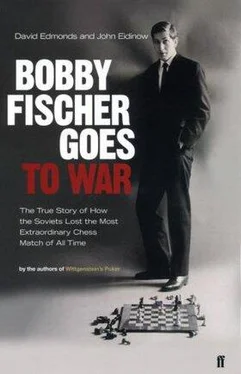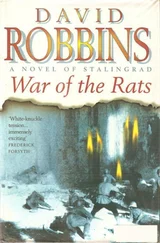Intriguingly, the detailed information in the dossier puts a question mark over Bobby’s official parentage: If Gerhardt was his biological father, when did he and Regina conceive their son? Bobby was born in 1943. While Gerhardt and Regina divorced only in 1945, they were physically apart from 1939, though Regina is reported as saying—presumably in an attempt to explain Bobby—that she and Gerhardt had a 1942 rendezvous in Mexico.
Some continuing relationship between them is indicated by Regina’s making a move to visit her husband in 1944—though there is no hint as to her motive or intention. She applied for a visa to Chile, but the wartime Department of State returned the forms to her because some details were missing. In May 1945, she presented a statement from the University of Chile offering her a place as a student. She never took this up: the divorce came through four months later. The FBI files contain no evidence that Gerhardt tried to join her in the United States before or after Bobby’s birth. What is more, on several occasions she confessed to not having seen her husband since 1939.
If not Gerhardt, who? For reasons never elucidated—always blanked out—there are copious notes on Dr. Paul Felix Nemenyi in the files on Regina. He is described as having a large nose, large knobby fingers, and an awkward, slovenly walk and dress.
Born into a Jewish family in Fiume in Hungary on 5 June 1895, Nemenyi was educated at the Institute of Technology in Budapest and in Berlin. He then held research fellowships in Copenhagen and Imperial College, London. In 1939, he emigrated to the United States. There he worked as a mathematics teacher and later as a mechanical engineer in a highly sensitive post in the Naval Research Laboratory in Washington, D.C. His expertise was in fluid mechanics. He died at a dance in Washington, D.C, on 1 March 1952. The FBI suspected that he too was a communist.
The notes offer an account of the relationship between Regina and Paul that points in one direction only: Nemenyi was Bobby’s biological father. A year before Bobby was born, Nemenyi befriended Regina when he was an assistant mathematics professor in Colorado. After Bobby was born, he took a special interest in the child. When Regina moved to Washington with her new baby, it looks as if it was Dr. Nemenyi who found her an apartment to stay in and paid the rent. After she relocated to New York, he paid for Bobby’s attendance at Brooklyn Community College and sent Regina $20 a week. He seemed to visit his son often enough for Bobby to become attached to him. At one stage, in 1948, the Bureau discovered Nemenyi telling a social worker that he was very upset about the way Bobby was being brought up, particularly because of the “instability of the mother.”
Letters written to and by Nemenyi’s son, Peter, who became a civil rights activist, are now available and appear to put the identity of Bobby’s biological father beyond doubt. In the month his father died, Peter wrote to Bobby’s psychiatrist, Dr. Kline, asking for advice on who should inform Bobby of Nemenyi’s death; he assumed the doctor knew that Nemenyi was Bobby Fischer’s father. The following month, Begina wrote to Peter complaining that she had no money for food or to repair Bobby’s shoes. Bobby had been feverish, but she could not afford a doctor. In an imploring tone, she asked whether Nemenyi had left Bobby any money. She told Peter that Bobby was still expecting Nemenyi’s visits; she had not told him of the death.
It seems unlikely that anybody ever told him. If the FBI had not delved so carefully into Regina’s life, and if Bobby Fischer, the world chess champion, had not remained an object of fascination for press and public to this day, his family secret would have remained just that.
a1… b1… g1… h1… a2… h2, and so on—Each of the sixty-four squares on the chessboard has a unique coordinate, from a1 to h8. a1 to a8 runs down a “file,” from white to black; al to h1 runs down a “rank,” from one side of the board to the other. This is the algebraic notation for identifying squares on the board. Thus, “Re3,” means the rook moves to the “e3” square. In 1972, most people operated with another language. A white move of the pawn to e4—the pawn to the fourth square of the king file—was written down as “P-K4.” When black moved, his/her moves were seen from his/her side: thus, if black moved his/her king’s pawn two squares (to e5), this was also jotted down as “P-K4.”
Castle—A maneuver in chess in which the king moves two squares and the rook jumps over it to the adjacent square. Each side can perform this maneuver only once per game. This is the only maneuver in chess in which two pieces are moved simultaneously. It is allowed under the following conditions: 1) there can be no pieces between the king and rook; 2) neither the king nor the rook can previously have moved; 3) the king cannot be in check; 4) nor can the king pass over a square that is under attack by an opposing piece.
Central Committee of the Communist Party of the Soviet Union (CPSU)—The governing body of the Communist Party. The general secretary (or first secretary) was the true leader of the USSR.
Checkmate—The king is attacked and cannot escape; the end of the chess game.
Federal Bureau of Investigation (FBI)—Founded in 1908 as the Bureau of Investigation, it is the investigative arm of the U.S. Department of Justice and answerable to the U.S. attorney general. Broadly, it investigates cases where a federal interest is involved. At the period of this story, its name was inseparable from that of J. Edgar Hoover, who had been director since 1924.
Fédération Internationale des échecs (FIDE)—Formed in 1924, it has responsibility for the organization of chess at the international level, including the rules of play and international championships. The membership is of national chess federations.
Grandmaster—The highest international ranking of a player. The title is earned through a complex rating system but essentially requires several strong results in top-class tournaments. “International master” is the next highest ranking. In 1972, there were approximately ninety grandmasters; there are now six times that number.
Icelandic Chess Federation (ICF)—Responsible for organized chess in Iceland.
Komitet Gosudarstvennoi Bezopasnosti (KGB)—Committee for State Security, successor to the secret police, the NKVD.
Komsomol—The Youth League of the Communist Party.
Narodnyi Komissariat Vnutrennikh Del (NKVD)—People’s Commissariat for Internal Affairs, the state security organization until 1943. With its own armed force and control over the penal system, it answered directly to Stalin and included the political police, ordinary police, and border troops.
Opening—There are no fixed frontiers separating the three phases of chess—the opening, the middle game, and the ending—but the opening covers the first moves of the game, often well known to the players from their experience and from study to the players; in the middle game, the majority of the pieces will still be on the board, but the game will have entered virgin territory; and the ending is usually marked by the disappearance of the queens.
Politburo—The policy-making body or cabinet of the CPSU Central Committee and center of Soviet political power.
Second—A chess player who supports another player, in a tournament or a match, with opening preparation and, when unfinished games were adjourned, with adjournment analysis.
Читать дальше












